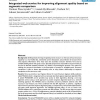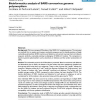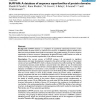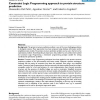BMCBI
2004
13 years 11 months ago
2004
BMCBI
2004
13 years 11 months ago
2004
BMCBI
2004
13 years 11 months ago
2004
Background: The proliferate nature of DNA microarray results have made it necessary to implement a uniform and quick quality control of experimental results to ensure the consiste...
BMCBI
2004
13 years 11 months ago
2004
Background: We have compared 38 isolates of the SARS-CoV complete genome. The main goal was twofold: first, to analyze and compare nucleotide sequences and to identify positions o...
BMCBI
2004
13 years 11 months ago
2004
Background: High-density oligonucleotide microarray technology enables the discovery of genes that are transcriptionally modulated in different biological samples due to physiolog...
BMCBI
2004
13 years 11 months ago
2004
Background: SUPFAM database is a compilation of superfamily relationships between protein domain families of either known or unknown 3-D structure. In SUPFAM, sequence families fr...
BMCBI
2004
13 years 11 months ago
2004
Background: The protein structure prediction problem is one of the most challenging problems in biological sciences. Many approaches have been proposed using database information ...
BMCBI
2004
13 years 11 months ago
2004
Background: The development of software tools that analyze microarray data in the context of genetic knowledgebases is being pursued by multiple research groups using different me...
BMCBI
2004
13 years 11 months ago
2004
Background: Researchers who use MEDLINE for text mining, information extraction, or natural language processing may benefit from having a copy of MEDLINE that they can manage loca...
BMCBI
2004
13 years 11 months ago
2004
Background: Alternative splicing is an efficient mechanism for increasing the variety of functions fulfilled by proteins in a living cell. It has been previously demonstrated that...





